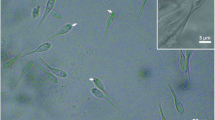Summary
1. The morphology and life-history of a new haplosporidian parasite,Coelosporidium schmackeriae, from the body cavity of the copepodSchmackeria serricaudata is described.
2. The earliest stage observed was an amoebula which developed into multinucleate plasmodia.
3. The plasmodia may undergo a process of asexual multiplication or plasmotomy and this may be repeated.
4. Spore formation took pláce inside the plasmodia by the fragmentation of the cytoplasm into uninucleate bodies and these bodies ultimately developed into uninucelate simple spores enclosed in a common cyst.
5. Cysts are ovoid measuring 25·0µ in diameter and enclose 70–80 spores. The spore is ovoid measuring 3·0µ × 27sd5µ and provided with a rigid double envelope. Neither an operculum nor a bivalve nature of the spore was noticed.
6. The systematic position of the parasite is discussed.
Similar content being viewed by others
References
Ashworth, J. H... “OnRhinosporidium seeberi Wernicke, 1903, with special reference to its sporulation and affinities,”Trans. Roy. Soc. Edinburgh, 1923,53, 301–42.
Caullery, M. and Mesnil, F. .. “Recherches sur les Haplosporidies,”Arch. Zool. exper. gen. (Ser. iv),4, 101–80.
Chatton, E... “Les peridiniens parasites. Morphologie, reproduction, ethologie,”Arch. Zool. exp. gen., 1920,59, 285.
Debaisieux, P. .. “A propos des cnidosporidies des Blattides,”C.R. Soc. Biol., Paris, 1927, 1404–06.
Ganapati, P. N. and Narasimhamurti, C. C. “On a new haplosporidian (Protozoa)Nephridiophaga xenoboli in the gut of a millipedeXenobolus carnifes,”Parasitology 1960,50, 581–85.
Ivanic, M... “Die Entwicklungsgeschichte und die parasitäre zerstorungsarbeit einer in den Malpigischen Gefässe der Honigbiene (Apis mellifica L.) schmarotzenden Haplosporidie,Nephridiopphaga apis gen. n., Spec. nov.,”La Cellule, 1937,45, 291–327.
Jepps, M. W... “On the protozoan parasites ofCalanus finmarchicus in the Clyde Sea area,”Quart. J. micr. Sci., 1937,79. (New ser.), 589–685.
Kudo, R. R. ..Protozoology, 4th Ed., Charles C. Thomas, Springfield, Illinois.
Laveran, A. and Petit, A. .. “Studies onIchthyophonus hoferi,”C.R. Acad. Sci., 1910,151.
Sprague, V... “Observations onCoelosporidium periplanateae with special reference to the development of the spore,”Trans. Amer. micr. Soc., 1940,59, 460–75.
Author information
Authors and Affiliations
Rights and permissions
About this article
Cite this article
Ganapati, P.N., Narasimhamurti, C.C. & Shanthakumari, K. A new haplosporidian parasite,Coelosporidium schmackeriae from the body cavity of a marine copepodSchmackeria serricaudata . Proc. Indian Acad. Sci. 60, 309–314 (1964). https://doi.org/10.1007/BF03053888
Received:
Issue Date:
DOI: https://doi.org/10.1007/BF03053888




